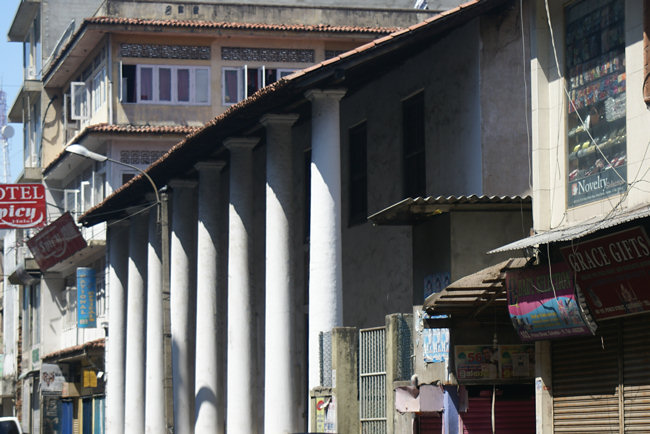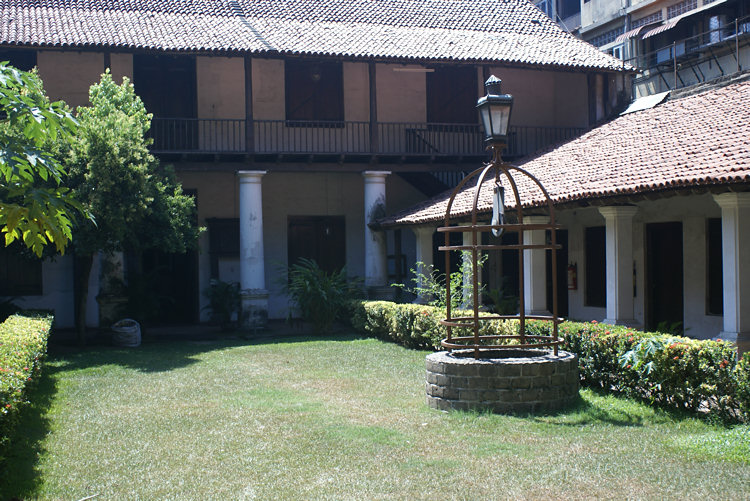Dutch Museum in Colombo
This must be on the list of places to see for all visitors to Colombo. It can be found just north of the Colombo Fort Railway Station in the heavily built up area called Pettah. In the late 1600's it was the Dutch East Indies Company VOC Governor's official residence in Colombo.

Colombo Old Dutch Museum in Pettah Sri Lanka
It is one of the few building examples left standing from that period in history. You will find it at 95 Prince Street. It is very identifiable as it is a tall building painted white and has a row of classical columns holding up the red tiled roof facing the street. It is surrounded by antique shops and market stalls. It is open between 9am and 5pm every day except Friday. Entrance is free but you are expected to tip the official guide. The interior court yard garden is charming.
Colonnades were introduced into the design of Dutch buildings in the Tropics to give much needed shade to the open windows to try and keep the inhabitants cooler on hot dry days. They also provided much needed shelter from the monsoon intense rain storms. The over hanging roof channelled the great volumes of rain water that can occur in one of these deluges into the street and away from the house.
You will notice that there is no guttering system. On the outside of the building there are wood shuttered windows on two levels which contrast dramatically with the whitewashed plastered walls. Study the craftsmanship of the giant wooden doors.

The courtyard garden of the old Dutch museum Colomco Sri Lanka
Inside the complex you will find a court yard garden with its own well, fruit, nut and spice trees. It is a pleasant oasis where you can escape the hustle and bustle of the crowded dirty shopping streets of Pettah. Make sure you have some cold bottled drinks in your bag before you go in. Find a corner of the garden in the shade and sit down. Take the weight of your feet and have a cool drink. There are no refreshments for sale inside the museum. There are toilets at the back of the garden.
The building was constructed during the Dutch occupation of Colombo (1656 - 1796) and was the formal residence of the Dutch East Indies Company Colonial Governor Van Rhee during his term of office in 1692 to 1697. At that time the surrounding streets in Pettah were very wide with rows of trees to give shade for those walking on the smooth and regular pavement. The area was described by a visiting English Doctor in 1757 as very elegant. Unfortunately these attractive avenues now no longer exist and the shopping bazaar of Pettah is full of narrow scruffy streets where vehicles have problems passing each other.

The well in the VOC Old Dutch East Indies Company Colonial Goveners house
The building has been used for many different purposes over the years. It was a teacher training college and an institute for the instruction of clergymen between 1696 and 1796. There is an inscription over the entrance in Latin that dates from this period. It says 'NisiJuehova aedificet domum, frustra laborant aedificatores' which means unless 'God builds the house, the workers toil in vain' Psalm 127.
There are documentary references that this building operated as an orphanage under the supervision of the deacons and financed by the Dutch East Indies Company VOC and with the help of private funding. It was also used as a hospital. It became a barracks in the second half of the 1800s. In 1900 a police training school was set up by the British and later in 1932 it became the Pettah post office.
Inside the museum you will find examples of old Dutch artifacts, coins, glassware, ceramics, weapons, gunpowder horns, tall twisted sandalwood candle holders, a child's cot, bells, alloyed candelabras and furniture. Many of the items are decorated with tortoise shell which was the fashion them. There are many historical documents and portraits from the Dutch Colonial period.
Old graves stones that date from this period have been rescued and are on display. Work out how old most of the people were when they died. You will come to the conclusion that many Europeans died young. Watch out for locals trying to sell you fake Dutch Colonial money when you leave.
Travel books

